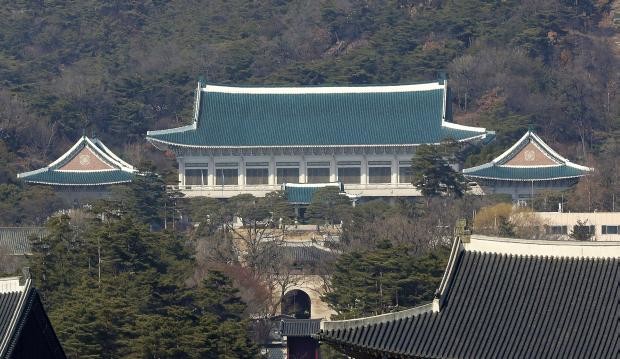
This photo, tkaen March 10, 2017, shows the presidential Blue House in Seoul, South Korea. As president, Park Geun-hye led a life that always seemed to revolve around South Koreaâ’s huge presidential palace. But for the next several months she will have to on a much smaller scale in a solitary cell at the Seoul Detention Center. She was driven there in a black sedan before dawn Friday, March 31, 2017, after a court approved her arrest on corruption allegations. (Photo by LEE JIN-MAN / AP)
SEOUL, South Korea — For a person whose life always seemed to revolve around South Korea’s huge presidential palace, the next several months will be lived on a much smaller scale.
Park Geun-hye entered the Seoul Detention Center in a black sedan before dawn Friday after a court approved her arrest on corruption allegations.
The ousted president registered her name and ID number, went through a simple health checkup, and gave up her personal belongings, including hairpins that held up her signature bun. She then changed into light-green prison clothes and was locked in a solitary cell, according to a detention center official who didn’t want to be named, citing office rules.
Park’s cell has a television, a toilet, a sink, a table and a mattress. She will be asked to rise at 6 a.m. and go to sleep at 8 p.m. She will have to eat at her cell and also wash her own plate, the official said. A typical solitary cell at the detention center is 6.56 square meters (7.8 square yards).
“She will go through the same routines as other inmates,” the detention center official said.
Park is expected to spend several months in the detention center while court proceedings are taking place.
She has lived in the presidential Blue House twice, first as the daughter of military strongman Park Chung-hee, who moved into the palace in 1963, two years after he staged a coup and took control of the country.
Park left the Blue House following the assassination of her father in 1979. But, following a meteoric political career, she returned after winning the presidency in December 2012, thanks to overwhelming support from older voters who remembered her father as a hero who rescued the nation from poverty, despite his brutal record of civilian oppression.
Park’s term was to have ended in February 2018, but the Constitutional Court removed her from office on March 10 over the corruption scandal.
Occupying the slopes of a downtown Seoul mountain, the Blue House is large compound where hundreds of people work in several buildings, including a blue-roofed, 8,476-square meter (10,137 square yard) hall where the main presidential office is. When she used the office, Park needed to walk about 15 meters (16 yards) just to get to her desk from the door.
She is the second former president to be held at the Seoul Detention Center, which keeps criminal suspects in custody before conviction. Roh Tae-woo, who was president from 1988 to 1993, was locked there after a 1995 arrest for bribery. He was convicted and sentenced to prison but was pardoned in 1997.
Its current detainees include other key figures in the corruption scandal that toppled Park, including her longtime friend, Choi Soon-sil, who is suspected of colluding with Park to extort money and favors from companies and secretly interfering with state affairs.
Billionaire Samsung heir Lee Jae-yong was detained there after being arrested for allegedly using tens of millions of dollars in corporate funds to bribe Park and Choi in exchange for business favors.
Park’s former culture minister, Cho Yoonsun, and her ex-chief of staff, Kim Ki-choon, are also being held at the detention center following their arrests over suspicions that they blacklisted thousands of artists deemed as unfriendly to Park to deny them state support.
The current Seoul Detention Center opened in Euiwang city in 1987. It replaced a facility originally built as a prison in Seoul in 1908. During Japan’s colonial rule over the Korean Peninsula, the prison was notorious as a torture center for Korean independence activists. After colonial rule ended at the close of World War II, South Korea used the facility as a prison and later as a detention center. –Kim Tong-Hyung/rga